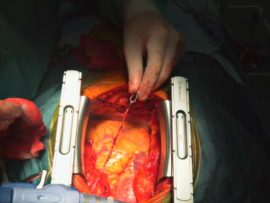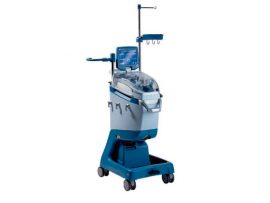Abstract OBJECTIVES The invention of new surgical procedures requires testing at different stages including animal models. To facilitate this process, we have developed a computer-controlled extracorporeal circulation system for testing..
Read MoreAbstract OBJECTIVES Post-cardiotomy cardiogenic shock (PCCS) results in substantial morbidity and mortality, whereas refractory cases require mechanical circulatory support (MCS). The aim of the study was to compare extracorporeal membrane..
Read MoreAbstract OBJECTIVES Although total blood volume (TBV) is central to the estimation of the haemodilution rate during cardiopulmonary bypass (CPB), conventional formulas lack sufficient accuracy. The aim of this study..
Read MoreAbstract Background The objective of this study was to assess the incidence of in‐hospital acute kidney injury (AKI) after cardiac surgery by comparing preoperative baseline renal function with renal function..
Read MoreAbstract New threats to effective scientific communication make it more difficult to separate science from science fiction. Patients can be harmed by misinformation or by misplaced trust; for example, patients..
Read MoreAbstract The proportion of patients receiving intravenous gelatin‐based colloids has increased in the last decade due to safety concerns about starch‐based products. Recent research suggests hypersensitivity reactions to intravenous gelatin‐based..
Read MoreAbstract Background: Cardiac surgery is associated with peri-operative bleeding, which may result in the need for blood transfusion, particularly in paediatric congenital cardiac surgery on cardiopulmonary bypass (CPB). There is..
Read MoreAbstract The aim of the study was to evaluate the disposition of plasma unbound cefazolin in patients undergoing cardiothoracic surgery with cardiopulmonary bypass (CPB). Adult patients undergoing cardiothoracic surgery with..
Read MoreAbstract In this issue of the ASAIO Journal, Keane et al. present the results of their exploratory study on the combined use of whole body bioimpedance (WBB) and relative blood volume (RBV) monitoring..
Read MoreAbstract Background Fish oil is among the most common natural supplements for treatment of hypertriglyceridemia or prevention of cardiovascular disease. However, concerns about theoretical bleeding risk have led to recommendations..
Read MoreAbstract Background There is growing evidence regarding the importance of contextual factors for patient/staff outcomes and the likelihood of successfully implementing safety improvement interventions such as checklists; however, certain literature..
Read MoreAccording to the US Department of Health and Human Services, “Research misconduct means fabrication, falsification, or plagiarism in proposing, performing, or reviewing research, or in reporting research results.” Other important irregularities..
Read MoreAbstract Background Adult cardiac surgery with extracorporeal circulation is known to be associated with increased risk of blood transfusion leading to adverse outcomes. Procedures like retrograde autologous priming (RAP) may..
Read MoreAbstract According to a survey by the University of Ottawa in 2009, we have surpassed the 50 million mark over the total number of scientific articles published since 1665, and..
Read MoreSelective visceral perfusion improves renal flow and hepatic function in neonatal aortic arch repair
Abstract OBJECTIVES The aortic arch repair in the neonatal period is a complex procedure with significant morbidity. We define a useful double-perfusion technique and its effect on the function of..
Read MoreAbstract A best evidence topic in cardiac surgery was written according to a structured protocol. The question addressed was ‘In patients undergoing off-pump coronary artery bypass grafting, for single or..
Read MoreAbstract Objective Prolonged intensive care unit (ICU) stay prevents the use of ICU equipment by other patients and increases hospital cost. This retrospective study aimed to investigate the risk factors..
Read MoreAbstract This article seeks to understand whether a volume–outcome relationship exists in adult extracorporeal membrane oxygenation (ECMO). We examined primary administrative discharge data from the Pennsylvanian Health Care Cost Containment..
Read MoreAbstract Low plasma fibrinogen level is common after cardiopulmonary bypass (CPB). Current substitution practice with fibrinogen concentrate generally follows a single measurement and cut-off values from the literature, whereas early..
Read MoreAbstract Background Donation after circulatory death (DCD) can increase the pool of available organs for transplantation. This pilot study evaluates the implementation of a controlled DCD (cDCD) protocol using normothermic..
Read MoreAbstract Objective: Hemodilution is a concern in cardiopulmonary bypass (CPB). Using a smaller dual tubing rather than a single larger inner diameter (ID) tubing in the venous limb to decrease..
Read MoreAbstract When designing a clinical study, a fundamental aspect is the sample size. In this article, we describe the rationale for sample size calculations, when it should be calculated and..
Read MoreAbstract The use of cell salvage is recommended when it can be expected to reduce the likelihood of allogeneic (donor) red cell transfusion and/or severe postoperative anaemia. We support and..
Read MoreAbstract Background Extracorporeal membrane oxygenation (ECMO) is increasingly used in resuscitation of critically ill patients with documented improved survival. Few studies describe ECMO use in cardiogenic shock. This study examines..
Read MoreAbstract Background Protamine neutralization is an essential step for the safe use and inactivation of the unfractionated heparin (UFH) that is widely employed in surgical and non‐surgical procedures involving extracorporeal..
Read MoreAbstract Background Since the 2009 pandemic influenza, we have nationally established a committee of the extracorporeal membrane oxygenation (ECMO) project. This project involves adequate respiratory management for severe respiratory failure..
Read MoreAbstract Introduction: Postoperative delirium is the most common neurological complication of cardiac surgery. Hypoxia has been shown to increase the risk of postoperative delirium. The possibility to continuously monitor oxygen..
Read MoreAbstract When designing a clinical study, a fundamental aspect is the sample size. In this article, we describe the rationale for sample size calculations, when it should be calculated and..
Read MoreAbstract For 3 decades, the American College of Cardiology (ACC) and the American Heart Association (AHA) have jointly developed clinical practice guidelines in an effort to align patient care with..
Read More


























